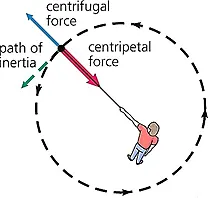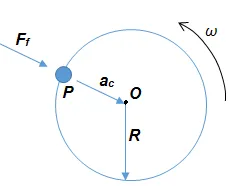Centrifugal forceCentrifugal force is the outward force on a body moving in a... More is the outward forceIn physics, a force is any influence that causes a free body... More on a body moving in a curved path around another body.

Centrifugal forceCentrifugal force is the outward force on a body moving in a... More(from Latin centrum, meaning “centre”, andfugere, meaning “to flee“) is the apparent forceIn physics, a force is any influence that causes a free body... More that draws a rotating body away from the centre of rotation. It is caused by the inertiaInertia is a property that causes a body to resist changes i... More of the body as the body’s path is continually redirected.
This Centrifugal forceCentrifugal force is the outward force on a body moving in a... More represents two types of forces which are both oriented away from the axis of rotation, but differ in terms of the object on which they are exerted.
The fictitious centrifugal forceCentrifugal force is the outward force on a body moving in a... More
It appears when a rotating reference frame is used for analysing the system. It is exerted on all objects in the frame, and directed away from the axis of rotation.
To illustrate this concept, consider a particlePthat is firmly sitting on a turntable, which is rotating about pointOat angular velocityω. The radius measured from pointOto the location of the particle isR.

The centripetal accelerationCentripetal acceleration is the acceleration toward the cent... More of the particle (ac) with respect to ground is: ac = ω2r
This acceleration is pointing towards the centreOof rotation.
The friction forceIn physics, a force is any influence that causes a free body... More (Ff) between the particle and turntable is holding the particle in place. This forceIn physics, a force is any influence that causes a free body... More is determined by applying Newton’s Second Law in the direction ofac.
Thus, Ff = mac. = m(ω2r)
wheremis the mass of the particle.
The reactive centrifugal forceCentrifugal force is the outward force on a body moving in a... More
This is the reaction to the centripetal forceCentripetal Force is the inward force on a body moving in a ... More, which is equal in magnitude to the centripetal forceCentripetal Force is the inward force on a body moving in a ... More, directed away from the centre of rotation. This forceIn physics, a force is any influence that causes a free body... More is exerted by the rotating object upon the object which exerts the centripetal forceCentripetal Force is the inward force on a body moving in a ... More.
The reactive centrifugal forceCentrifugal force is the outward force on a body moving in a... More (Fr )is given by Fr= m(ω2r)
This is the forceIn physics, a force is any influence that causes a free body... More acting on the particle as it revolves around on the turntable with centripetal accelerationCentripetal acceleration is the acceleration toward the cent... More (relative to ground).
Therefore, the reactive centrifugal forceCentrifugal force is the outward force on a body moving in a... More is the forceIn physics, a force is any influence that causes a free body... More exertedbythe particle onthe turntable. By Newton’s Third Law this forceIn physics, a force is any influence that causes a free body... More is acting in the direction opposite to the forceFc (centripetal forceCentripetal Force is the inward force on a body moving in a ... More). This is illustrated in the figure below.

Unlike a fictitious forceIn physics, a force is any influence that causes a free body... More, the reactive centrifugal forceCentrifugal force is the outward force on a body moving in a... More is areal forceIn physics, a force is any influence that causes a free body... More based on the acceleration of the particle relative to an inertial reference frame (ground), which is given by ar = ω2r
Both of the forces described above can be observed in action on a passenger sitting in a car. When a car travels around a corner, the passenger’s body pushes against the outer edge of the car. This is an example of the reactive centrifugal forceCentrifugal force is the outward force on a body moving in a... More, which can also be called a reaction force because it results from passive interaction with the car which actively pushes against the body.